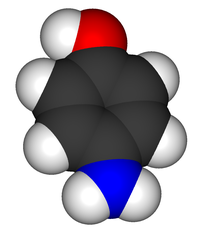
Photo from wikipedia
The reduction of p-nitrophenol to p-aminophenol has become a benchmark reaction for testing the efficiency of new catalytic systems. In this study, we use oxidatively modified carbon (OMC) as a… Click to show full abstract
The reduction of p-nitrophenol to p-aminophenol has become a benchmark reaction for testing the efficiency of new catalytic systems. In this study, we use oxidatively modified carbon (OMC) as a structural support to develop a new cost-efficient nickel-based catalytic system. The newly developed material comprises single nickel ions, chemically bound to the oxygen functional groups on the OMC surface. The highly oxidized character of OMC ensures the high lateral density of nickel ions on its surface at relatively low nickel content. We demonstrate excellent catalytic properties of the new material by using it as a stationary phase in a prototype of a continuous flow reactor: the reagent fed into the reactor is p-nitrophenol, and the product, exiting the reactor, is the fully converted p-aminophenol. The catalytic properties of the new catalyst are associated with its specific morphology, and with high lateral density of active sites on the surface. The reaction can be considered as an example of single-atom catalysis. The resulting material can be used as an inexpensive but efficient catalyst for industrial wastewater treatment. The study opens the doors for the synthesis of a new series of catalytic systems comprising transition metal atoms on the OMC structural support.
Journal Title: Molecules
Year Published: 2022
Link to full text (if available)
Share on Social Media: Sign Up to like & get
recommendations!